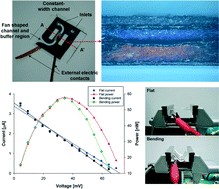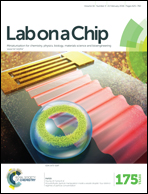Paper-based energy harvesting from salinity gradients†
Abstract
Paper-based microfluidic devices have many advantages such as low cost, flexibility, light weight and easy disposability. Especially, since they can intrinsically generate capillary-driven flow (no pumps are needed), paper-based microfluidic devices are widely used in analytical or diagnostic platforms. Along with advancements in microfluidic paper-based analytical devices (μPADs), energy generation using paper materials has received significant attention. In this study, environment-friendly and flexible paper-based energy harvesting with a simple configuration is demonstrated by using the principle of reverse electrodialysis (RED). RED is a promising clean energy generation method, which converts Gibbs free energy into electricity by salinity gradients without discharging any pollutants. However, the power efficiency in a conventional RED device is limited by the essential requirement of active pumping for providing high and low concentration electrolytes. Capillary pumping from the proposed paper-based RED can save this waste of energy, and moreover, the flexible device is realized with cost effective materials and a simple fabrication step, and is environmentally friendly. By thoughtful analysis of voltage–current experiments and capillary flow rates in paper channels, the optimized channel width interfacing with a selective membrane is determined as 2 mm and the maximum power and power density are achieved as 55 nW and 275 nW cm−2, respectively. 25.8% of the generated maximum power is successfully saved by realizing the pumpless RED system. This paper-based RED device can be integrated directly with μPADs as a practical application.


 Please wait while we load your content...
Please wait while we load your content...